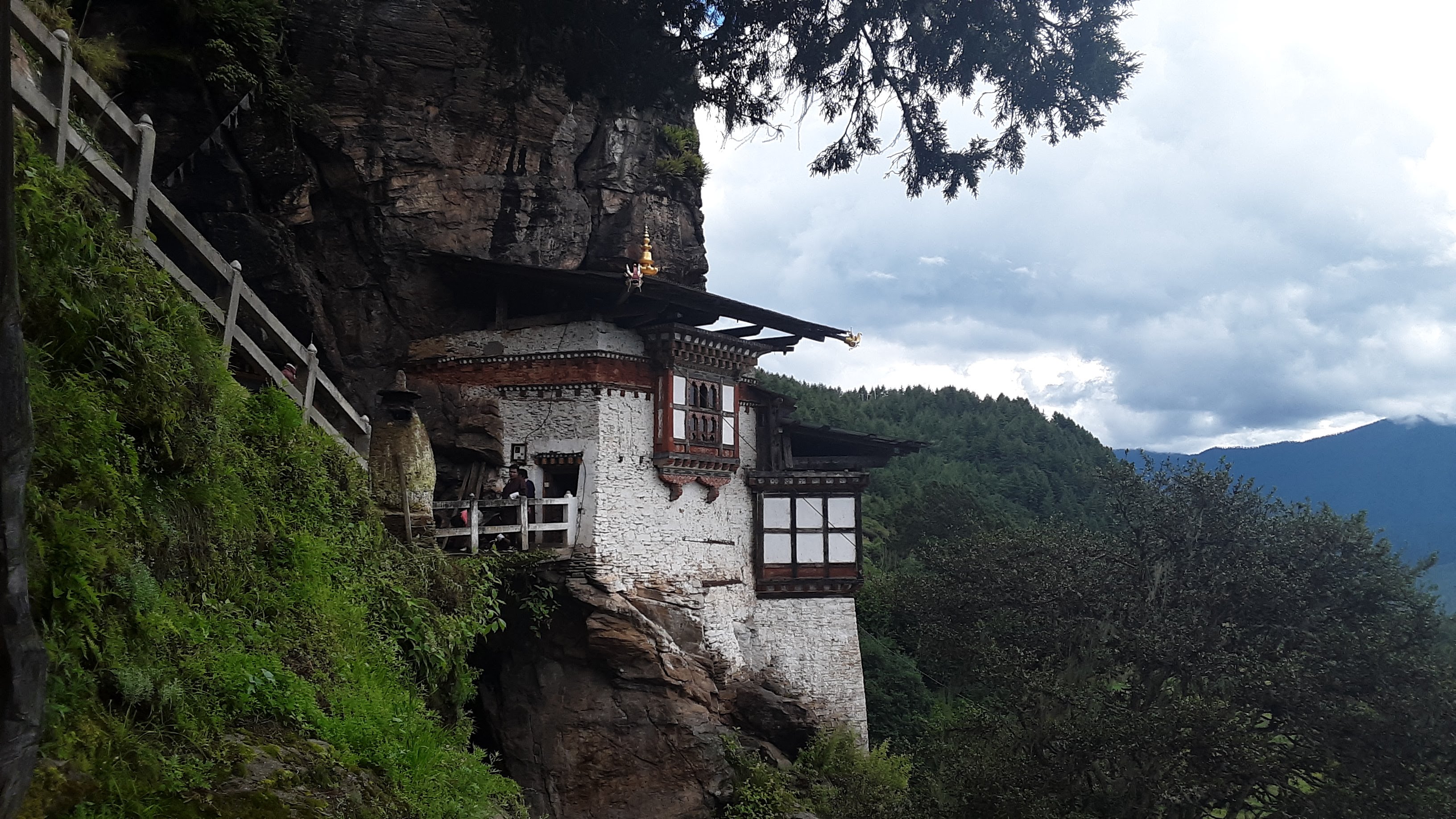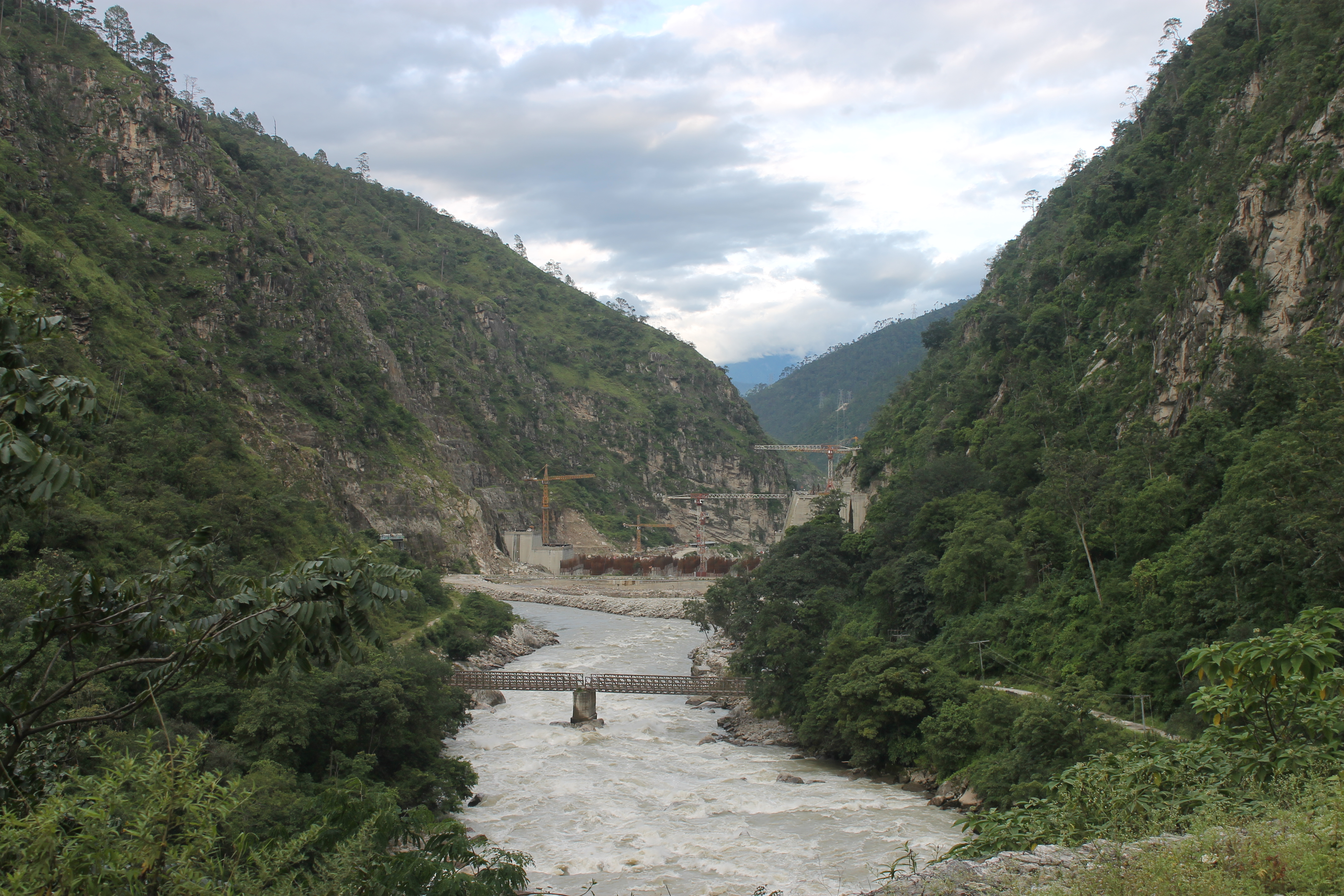
I was in Bumthang, a district in central Bhutan, on a very auspicious day. It was August 4, the First Sermon of Lord Buddha. My guide, driver, and I hiked up to a Buddhist temple nestled into the cliffs high above the valley to present some offerings and receive some blessings.
The temples in Bhutan are true works of art. Often located at dizzying heights and requiring a steep hike straight uphill to reach them, they are beautifully crafted structures, painted stones in bright white with a red band around the building near the top and a sloping carved wood roof. The insides have colorful patterned fabrics draping from the ceilings, hand-painted walls depicting gods and religious scenes, elaborately carved and painted wooden pillars, an altar full of bright sugar sculptures and flowers, and behind some glass, golden statues of the Buddha or other important religious figures. It is an explosion of color.
We entered the temple and made prostrations to show reverence—our hands together in prayer, touching two thumbs first to the top of your head, then to the third eye on your forehead, then to your lips, finally fully bowing with your knees on the ground and hands in front of you, touching your forehead to the floor. This process is repeated three times, first to the painting or seat of the teacher in the back of the temple, and then to the Buddha or other statue behind the altar. I fold a bill and put it to my forehead, eyes closed, sending out prayers to the world. I put the money on the altar, and then turn to the presiding monk, who is holding a delicate container with a long spout. In it is blessed water, mixed with oils and herbs. He puts a few drops into my outstretched palm, and I sip the blessings, putting the rest on the back of my head.
Water is an important part of the practice of Vajrayana Buddhism, the state religion and one of the three main branches of Buddhism, in Bhutan. Water is offered on the altar in special silver cups. Water is given to the devoted souls who visit the temples, literally drinking the blessing from the gods.
There are whole bodies of water that Bhutanese regard as spiritual sites as well. One was just further down the valley from the temple I visited, called The Burning Lake, or Membar Tsho in Dzongkha, the official language of Bhutan. According to Bhutanese history, Burning Lake is where Guru Rinpoche, an 8th century Buddhist master and the founder of Tibetan Buddhism, hid some sacred treasures, where they would remain until someone worthy could find them. In the 15th century, a Buddhist saint named Pema Lingpa came to the lake to find the treasure. With a lit lamp, he dove into the lake and returned with the treasures, his lamp still burning brightly. It is for this reason that the place is called Burning Lake and it remains a very sacred site for the Bhutanese. People continue to light butter lamps, hang prayer flags, and leave small clay structures around the lake.
Sometimes water bodies can also be the site of a subdued demon, where a Buddhist master used religious structures and water to banish evil spirits from the land. In these places, as well as spiritual waters such as the Burning Lake, people are never supposed to go into the water. Others, however, are blessed water, such that it is beneficial to people to take a dip. This is the case for the naturally occurring hot springs in the northernmost district of Gasa, which are said to have been blessed by Guru Rinpoche and can help cure ailments physical, mental, and spiritual.
Getting a blessing from a high Buddhist master is a special and auspicious event in Bhutan. And blessings also need to be given for Bhutan's biggest water projects—hydropower. Many of the projects have been visited by the Je Khenpo, The Chief Abbot of the Central Monastic Body of Bhutan. He is the top-most religious figure in Bhutan, and his blessings are regarded as extremely powerful.
The Je Khenpo blessed the Mangdechhu hydropower project, Bhutan's newly completed hydroelectric facility, the morning that I visited. We passed his caravan of cars on our way to the facility and stopped respectfully to let him pass, our heads bowed. We saw local people dressed in the Bhutanese national dress of a gho for the men and a kira for the women standing by the side of the road, waiting to receive the Je Khenpo's blessing as he drove by.
His Holiness's intervention is also required when projects are not going as planned. The two biggest hydropower plants in Bhutan so far are currently under construction: Punatsangchhu-I and II. These two projects have been plagued by geologic problems and are years behind schedule. There is no clear completion date in sight for either, putting Bhutan billions of ngultrums, the local currency, in debt. At Punatsangchhu-I, a huge landslide on one of the steep riverbanks in 2013 caused work on the dam to grind to a halt, and even now, six years later, the bank remains too unstable to build on. The entire mountainside is slowly creeping forward at a rate of 7-8mm a month, and officials at the dam have no way of stopping this steady march forward. With no technical solutions yet to the problem, the Je Khenpo arrived to perform a large ritual at the dam site. Now, many of the workers are tasked with building a stupa, or a structure with religious relics inside, on the geologically-unstable bank to try and appease the evil spirits that are there and stabilize the mountain.
Many Bhutanese have strong faith that this stupa could be what is needed to set the Punatsangchhu-I project back on track. Even with Bhutan's largest water-based projects, religion is a critical part of their functioning and completion. Seeing how deeply water and Buddhism are tied together, I could also imagine how climate change could impact the spiritual connection between people and the water they depend on. In my reporting, I am hearing about drying springs, extreme rain events, and melting glaciers—perhaps indicating that the spirits and gods in Bhutan are sending a message of warning to the Bhutanese through the unstoppable, powerful water.









